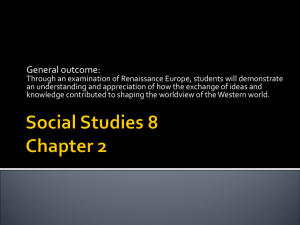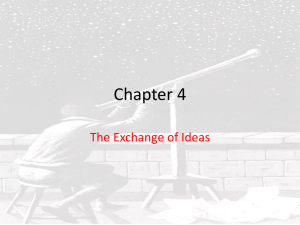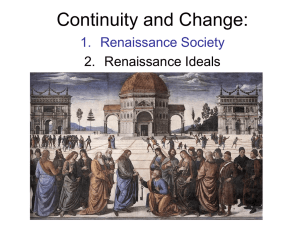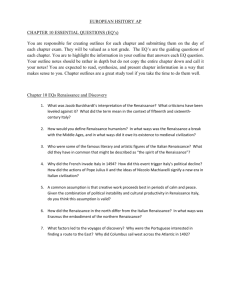Lesson
advertisement
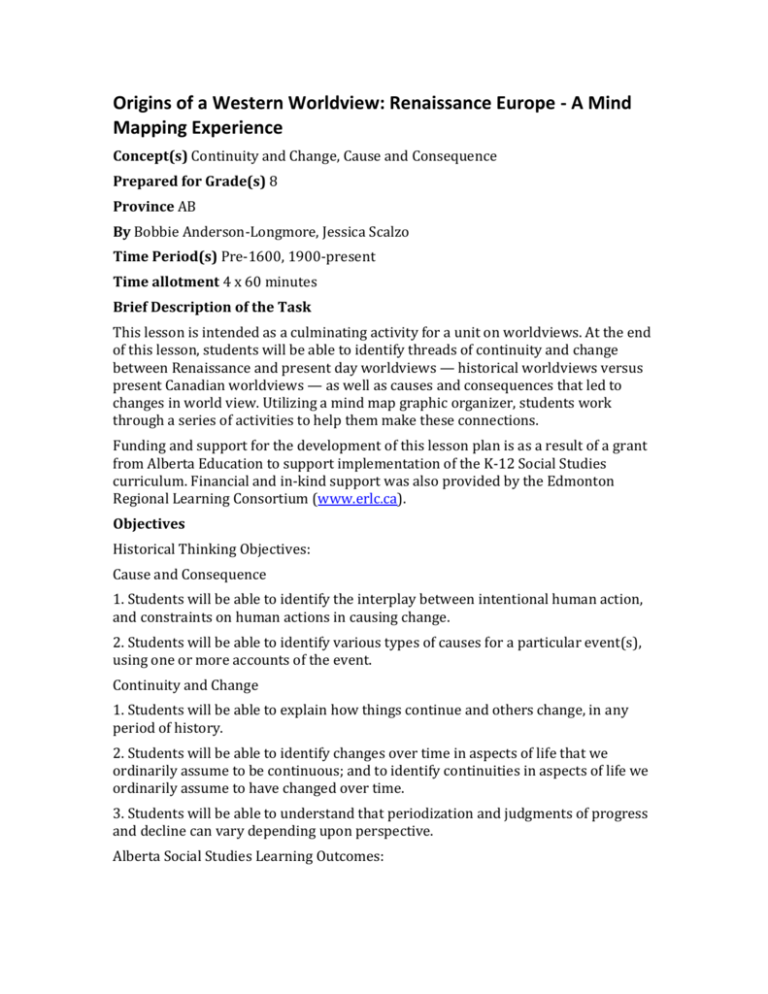
Origins of a Western Worldview: Renaissance Europe - A Mind Mapping Experience Concept(s) Continuity and Change, Cause and Consequence Prepared for Grade(s) 8 Province AB By Bobbie Anderson-Longmore, Jessica Scalzo Time Period(s) Pre-1600, 1900-present Time allotment 4 x 60 minutes Brief Description of the Task This lesson is intended as a culminating activity for a unit on worldviews. At the end of this lesson, students will be able to identify threads of continuity and change between Renaissance and present day worldviews — historical worldviews versus present Canadian worldviews — as well as causes and consequences that led to changes in world view. Utilizing a mind map graphic organizer, students work through a series of activities to help them make these connections. Funding and support for the development of this lesson plan is as a result of a grant from Alberta Education to support implementation of the K-12 Social Studies curriculum. Financial and in-kind support was also provided by the Edmonton Regional Learning Consortium (www.erlc.ca). Objectives Historical Thinking Objectives: Cause and Consequence 1. Students will be able to identify the interplay between intentional human action, and constraints on human actions in causing change. 2. Students will be able to identify various types of causes for a particular event(s), using one or more accounts of the event. Continuity and Change 1. Students will be able to explain how things continue and others change, in any period of history. 2. Students will be able to identify changes over time in aspects of life that we ordinarily assume to be continuous; and to identify continuities in aspects of life we ordinarily assume to have changed over time. 3. Students will be able to understand that periodization and judgments of progress and decline can vary depending upon perspective. Alberta Social Studies Learning Outcomes: 8.2 Origins of a Western Worldview: Renaissance Europe General Outcome Through an examination of Renaissance Europe, students will demonstrate an understanding and appreciation of how the exchange of ideas and knowledge contributed to shaping the worldview of the Western world. Values and Attitudes 8.2.1 appreciate how Renaissance Europe formed the basis for the worldview of the Western world (C, TCC) 8.2.2 demonstrate a willingness to consider differing beliefs, values and worldviews (C, I) 8.2.3 recognize how beliefs and values are shaped by time, geographic location and societal context (C, TCC, LPP) Knowledge and Understanding 8.2.4 examine, critically, the factors that shaped the worldview evolving in western Europe during the Renaissance Skills and Processes 8.S.1 develop skills of critical thinking and creative thinking 8.S.2 develop skills of historical thinking 8.S.4 demonstrate skills of decision making and problem solving 8.S.8 demonstrate skills of oral, written and visual literacy See the Alberta Program of Study for specifics on these outcomes, processes, and skills. http://education.alberta.ca/media/773697/ss8.pdf Required Knowledge & Skills It is expected that students will have studied Renaissance and Western worldviews prior to engaging in this lesson (Note: This lesson can be adapted to other topics.) Students will be able to identify factors that influenced the development of the Western Worldview and will have demonstrated this knowledge through the unit work completed throughout the term, both verbally and in written form. Students will be familiar with the historical thinking concepts of cause and consequence and continuity and change. In addition to these core concepts, students require the foundational knowledge of building mind maps and a good working knowledge of linking words for mind map usage. Please see Attachment 1 — The Basic Laws of Mind Mapping, Attachment 2 — Steps in Making a Mind Map, and Attachment 3 — Linking Words Overhead for assistance. This task is one that is effective for a wide variety of topics in which you need to show relationships and/or comparisons between ideas, notions, and concepts. We have used this task at a variety of grade and ability levels, to much success. Recommended Resources: Bennett, Barrie and Rolheiser, Carol (2006). Beyond Monet: The Artful Science of Instructional Integration. Bookation Inc. Toronto, Canada Your preferred Renaissance textbook Historical Thinking Project web site for further information on the concepts of cause and consequence and continuity and change (http://historicalthinking.ca/historical-thinking-concepts) Click on the “Concepts” you are interested in learning more about, or read “Benchmarks of Historical Thinking: Framework for Assessment in Canada” by Peter Seixas. Required Materials: Poster paper of 2 various sizes Renaissance unit work Renaissance text Felts/colours Student handouts (see attachments) Access to digital photos for images Detailed Instructions Before beginning, complete the previously stated curricular objectives as articulated by Alberta Education that build background knowledge of the Renaissance and modern worldviews. Part A - Introducing Students to Mind Mapping 1. Begin by introducing the concept of Mind Mapping and the benefits of linking ideas and concepts learned in a unit with visuals and concise descriptions. You may wish to highlight the rise of scientific thinking including the work of Copernicus who through his empirical observations discovered that contrary to the received wisdom of the Church, Earth was not the centre of the Universe and in fact rotated around the sun. Discuss with students Attachment 1 — The Basic Laws of Mind Mapping, and Attachment 2 — Steps in Mind Mapping. Draw their attention to the fact that ideas radiate out from the central concept. Also, emphasize that these are mind maps, not concept maps or thought webs. The difference between a mind map and a concept map being is explained in Beyond Monet, 2006 (p.292): “A mind map is a visual representation that illustrates how one understands relationships between concepts. Those concepts could be any combination of things, people, ideas, arguments, solutions, places, etc. Mind mapping serves to move the learner from simply recalling facts to making the linkages or relationships between those facts. It encourages more complex and meaningful thinking.” The essential difference between mind maps and thought webs/concept maps is that mind maps explicitly show the relationships, connections, and linkages between the concepts being displayed. For further clarification, see the Beyond Monet teacher resource or view examples available on the Internet. 2. To help students understand the concept of mind mapping it would be helpful to first construct a mind map together as a class on a topic that students could contribute (e.g., a previous unit of study). The following steps will help students understand the process of creating a mind map: View Attachment 3 — Linking Words Overhead with the class and discuss how ideas relate to one another. Have students complete Attachment 4 — Linking Words Worksheet. Be sure to check in with students to ensure they have a solid understanding of how ideas relate, as understanding this is critical for the completion of the mind map task. Ask students what linking words they came up with and discuss what makes an effective/ineffective linking word. For example, effective linking words clearly identify the relationship between two ideas; ineffective linking words are vague and don’t accurately describe the relationship between two ideas. 3. Either collect the worksheet to be assessed or go over their answers as a class; before moving on to the next step. Part B - Introducing the Historical Thinking Concept of Cause and Consequence 1. To help students make connections between the mind mapping activity and events in the Renaissance, walk through several of the examples in Attachment 5 — Linking Words: Cause and Consequence Worksheet. Draw attention to the importance of the links between concepts. Have students brainstorm linking words that demonstrate cause and consequence relationships. For instance , the consequence of the invention of the printing press was that it became much easier to print books, pamphlets, and other documents. This led to a rise in literacy whereby it was no longer necessary to rely on a teacher or priest to gain knowledge. Rather it was possible to read and gain knowledge independently. Thus new ideas and knowledge became much easier to access and spread much more quickly. In small groups or individually, ask students to come up with more examples and discuss as a class to check their understanding of how to show relationships between ideas. 2. In order to help link the mind mapping exercise with the historical thinking concept of cause and consequence, provide students with an introductory example to which they can relate. Using an example of a school policy on cell phone use, illustrate the causes and consequences of this policy and model for students the skill of charting causes and related consequences of an event. As this pattern of cause and consequence is being established, explain that each cause can lead to a consequence, and correspondingly each consequence may in turn lead to another consequence which can then be further explored. Explore with students some possible consequences that could result from the reactions to the new school policy. Explain that “central to cause and consequence is the active role, or agency (who did what, who made it happen), that people (as individuals and groups) play in promoting, shaping, and resisting change in history. Causes are multiple and layered, involving both long term ideologies, institutions and conditions and short term actions and events.” Your discussion will result in students gaining a better understanding that: a) causes are multiple and layered, involving long term and short term actions, events, conditions, etc. b) actions often have unintended consequences. (Again, more information on these historical thinking concepts can be found at the Historical Thinking Project web site at http://www.historybenchmarks.ca 3. To link the concept of cause and consequence with the Renaissance activity, begin by discussing with students the importance of the relationship between Renaissance worldview/s and Western Worldview/s. Distribute Attachment 6 — Renaissance Mind Map Handout, and Attachment 7 — Rubric for Mind Map. Read through both documents with the student and check for understanding. Highlight for the students that to complete the task they will be choosing four of the major concepts as outlined on the student handout, with the Renaissance as the main concept in the centre. Encourage students to choose four topics that they find to be the most interesting. Allow time for students to discuss with other students their ideas as to how they will display their understandings of these major concepts. This is also a time for students to plan what colour patterns, images and pertinent mind mapping attributes they will employ to demonstrate their knowledge. Allow about three periods for students to complete their Renaissance Mind Map task. You may want to have students complete and submit a rough draft as the ideas they are expressing are complex and will most likely need refinement and reorganization. Allow students an opportunity to share their ideas with other students so they can gain more insight. For example, a Think-Pair-Share workshop would be a good opportunity to 'check-in' with the students. Part C: Continuity and Change - Connecting Renaissance World View/s with Modern Western World View/s 1. Remind students about “continuity and change” in history. Sometimes, it is easy to focus on the differences between the past and the present because they seem obvious to us. However, the concept of continuity and change enables us to also examine and understand that ideas from the past linger and persist to the present day. This part of the lesson will help students to explore this concept of historical thinking. Discuss continuity and change with students, emphasizing that it provides a fundamental way to organize the complexity of the past. Changes happen at different paces, at different times in history, and even at the same time in different aspects of life. Judgments of continuity and change can be made on the basis of comparisons between some point in the past and the present, or between two points in the past. Also, continuity and change are interrelated; processes of change are usually continuous, not isolated into discreet events. Within continuity, there exists change. Visit the Historical Thinking website for strategies to help students better understand the concept of continuity and change at http://www.historybenchmarks.ca 2. Once students have completed their mind map on an element of the Renaissance, direct them to place their Renaissance Mind Map on a larger piece of different colour paper. In the top left corner of the larger piece of paper, students need to label it “Today’s Western Worldview.” This larger piece of colour paper will enable students to differentiate visually between the Renaissance Worldview and the Western Worldview. In this step, students are required to make links between the past and the present by establishing links between the Renaissance worldview and the Western Worldview. They are required to show how present worldviews are linked in a continuous and connected way to historical worldviews. Students should be able to show how aspects of the worldviews have remained continuous (stayed the same) and which have changed (are no longer present). Students must again utilize their linking words to show the strength of these connections. To do this they will make links from their Renaissance Mind Map to the recently added, larger piece of coloured paper which represents “Today’s Western Worldview.” 3. Once students have completed the task, have them do their self-assessment (Attachment 8). These will be submitted alongside their mind maps.


